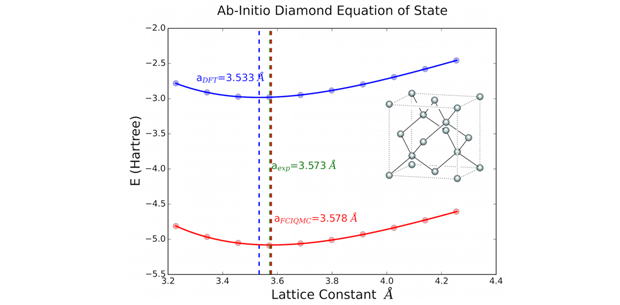Miguel Morales-Silva (15-ERD-013)
Abstract
We plan to develop a new capability for the accurate and efficient study of strongly correlated elemental materials with high atomic numbers from first principles. These materials are central to many of the critical missions of the Laboratory and are at the core of the theoretical high-energy-density and stockpile stewardship science performed at Lawrence Livermore. Many physics applications require equations of state that must span up to nine orders of magnitude in density. Because most of this area of interest is completely inaccessible to focused science experiments, we must rely on theoretical methods to quantify our equation-of-state uncertainties in these regimes. We will develop, implement, and apply the auxiliary-field quantum Monte Carlo method to quantify and significantly reduce the uncertainties in the equations of state, particularly in relation to actinides, by enabling the accurate study of strongly correlated high-atomic-number materials from first principles. The proposed method allows the calculation, by use of Monte Carlo techniques, of averages of operators in many-body mechanical problems. We will extend the capabilities of the method by incorporating the treatment of magnetism and relativistic effects, in addition to implementing novel wave functions. We will focus on the study of transition metal oxides and strongly correlated f-orbital electron systems, including lanthanides and actinides. The new capabilities will enable new science in the area of strongly correlated materials, advanced materials design, materials for energy production, and critical materials.
We expect to develop a modern and efficient implementation of the auxiliary-field quantum Monte Carlo method aimed at large-scale computational platforms to satisfy the needs for reliable prediction of material properties. Quantum Monte Carlo methods are among the most promising alternative for beyond-mean-field calculations, offering a direct advantage over other many-body approaches by using stochastic sampling rather than explicit integration over phases. Our goal is to exploit current high-performance computational resources, in addition to preparing an implementation that can be adapted to future exoscale resources. We will expand the capabilities of the method by extending the use of novel wave functions to real systems, in particular to materials with high atomic numbers. In addition, we will reformulate the method to incorporate both collinear as well as non-collinear magnetism and spin–orbit interactions. Finally, we will combine the method with the density-matrix embedding theory, resulting in a powerful framework for the study of strongly correlated electronic systems.
Mission Relevance
First-principles methods that can accurately treat strongly correlated materials with high atomic number are an integral part of theoretical high-energy-density and stockpile stewardship science at LLNL. With this research project, we will develop capabilities that will be helpful in quantifying and reducing the uncertainties in equations of state using computational methodology, in support of the Laboratory central mission in national security and core competencies in high-energy-density science and high-performance computing, simulation, and data science.
FY15 Accomplishments and Results
In FY15 we (1) developed a basic implementation of the auxiliary-field quantum Monte Carlo code, which has basic functionality and can scale to over 10,000 processors for production-level calculations; (2) interfaced the code to Molpro and VASP (Vienna Ab Initio Simulation Package), where it obtains the necessary matrix elements of Hamiltonian quantum mechanics for calculations (Molpro is a system of computer programs for molecular electronic-structure calculations and VASP is a software package used for quantum-mechanical molecular dynamic simulations); (3) determined that the code can currently perform all-electron, frozen-core orbital, effective-core potential, projector-augmented wave method, and ultrasoft pseudo-potential calculations; and (4) implemented the use of multi-determinant trial wave functions for both solid and molecular calculations and the calculation of reduced-density matrices used in explicitly correlated calculations. Applications can focus on the study of the phase diagram of iron and transition metal oxides, in addition to the study of molecular systems and simple solids for validation.






